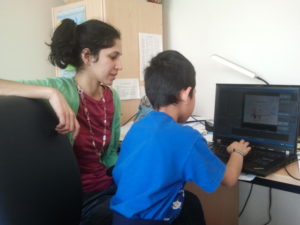In 2012, I was working at the Cooperative Oxford Lab in Oxford, Maryland, when we were notified of and rescued a stranded sea turtle. Sadly, the turtle was so sick that it died. An intern performed the necropsy (an autopsy on animals) and found that the turtle’s stomach was full of plastic trash and even a belt buckle and a hair comb. I never got the image of the dying turtle out of my head.
Meanwhile, besides mourning plastic-choked sea turtles, I was also feeling bewildered and upset by the constant talk from overseas outlaws, urging us Muslims living in the west to commit destructive acts. I decided I needed to do something to protest such talk, and it suddenly hit me that I could teach myself how to make animated videos declaring my love for the exquisitely lovely country of Sweden, where I used to live, and my darling home state of North Carolina. Little did I know that this commitment would eventually serve me in many more ways.
It took a few years, but a light bulb finally went off in my head, and I put two and two together: why not use my new animation skills to shed light on environmental concerns? Even better, why not do this as a project with children? This is how the animation “Mr. Turtle Gets Sick” came to be.

A second grade teacher at Northside Elementary, right here in Chapel Hill, graciously allowed me into her classroom last October through December. Along with help from my little brother, two fellow geology students, and especially my brother’s roommate, we first taught the children sea turtle ecology, let them draw illustrations, and recorded each child’s voice for the narration.

After this, we began animating. We first taught this to the whole class and then worked with each child individually. We provided the oversight and structure while letting the kids decide on the different actions and take the helm of doing the actual computer work. For example, if a child wanted to show Mr. Turtle swimming, then he or she specified Mr. Turtle’s position at both his start and end point, and the amount of time it took him to move that far. The fact that there was a “timeline” component meant that, in addition to the reading, artwork, and animation involved, the kids even practiced their math skills by learning how to space the actions out evenly. The illustrations the kids had drawn served as the background scenery.
At the unveiling, the children saw the finished product for the first time, and all the parents were invited for the viewing. The parents were thrilled! Afterwards, I contacted a local sea turtle expert, and he came to the classroom and did a follow-up presentation. He told the kids about sea turtle nests on North Carolina’s beaches, how sea turtles get caught in fishing nets, and how actually not all species of sea turtles eat jellyfish. The kids had so many questions that we kept going right until it was time to go to lunch.
Working with children was a beautiful experience, especially after being around academics all day. If anyone is interested and would like to be involved in future similar activities, please email me!
Animation: “Mr. Turtle Gets Sick”
Credits: Sharla Coleman’s second grade classroom at Northside Elementary, Mejs Hasan, Sean Catangui, Ali Hasan, Elsemarie deVries, Theo Jass
Software used: Blender, a free, open-source 3D modeling and animation program.
See ‘Mr. Turtle Gets Sick’ and other animations by Mejs here:
Mr. Turtle Gets Sick: http://youtu.be/ierH4oUaqO4
Dear Foreigner: http://youtu.be/jW99oPD3gK4
Freedom: http://youtu.be/H4inZuEF4ZM
Peer edited by Suzan Ok and Leanna Gentry.
Follow us on social media and never miss an article: